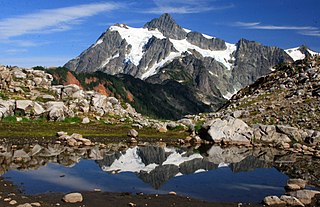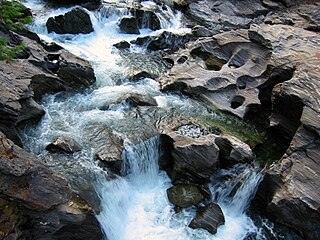
Mount Baker, also known as Koma Kulshan or simply Kulshan, is a 10,781 ft (3,286 m) active glacier-covered andesitic stratovolcano in the Cascade Volcanic Arc and the North Cascades of Washington State in the United States. Mount Baker has the second-most thermally active crater in the Cascade Range after Mount St. Helens. About 30 miles (48 km) due east of the city of Bellingham, Whatcom County, Mount Baker is the youngest volcano in the Mount Baker volcanic field. While volcanism has persisted here for some 1.5 million years, the current volcanic cone is likely no more than 140,000 years old, and possibly no older than 80–90,000 years. Older volcanic edifices have mostly eroded away due to glaciation.

Mount Adams, known by some Native American tribes as Pahto or Klickitat, is an active stratovolcano in the Cascade Range. Although Adams has not erupted in more than 1,000 years, it is not considered extinct. It is the second-highest mountain in Washington, after Mount Rainier.

The North Cascades are a section of the Cascade Range of western North America. They span the border between the Canadian province of British Columbia and the U.S. state of Washington and are officially named in the U.S. and Canada as the Cascade Mountains. The portion in Canada is known to Americans as the Canadian Cascades, a designation that also includes the mountains above the east bank of the Fraser Canyon as far north as the town of Lytton, at the confluence of the Thompson and Fraser Rivers.

The Wenatchee Mountains are a range of mountains in central Washington State, United States of America. A major subrange of the Cascade Range, extending east 50 miles (80 km) from the Cascade crest, the Wenatchee Mountains separate the drainage basins of the Yakima River from the Wenatchee River. The crest of the range forms part of the boundary between Chelan and Kittitas Counties.

Mount Daniel is the highest summit on the Cascade Range crest of Alpine Lakes Wilderness of the central Washington, United States. It is the highest point in King and Kittitas counties. Streams on its eastern slopes form the headwaters of the Cle Elum River.

The Enchantments is a region within the Alpine Lakes Wilderness area of Washington state's Cascade Mountain Range. At an elevation of 4,500 feet, it is home to over 700 alpine lakes and ponds surrounded by the vast peaks of Cashmere Crags, which rate among the best rock-climbing sites in the western United States. The highest peak, Dragontail Peak, stretches 8,840 feet high. The Enchantments is located 15 miles southwest of the popular Bavarian-themed town Leavenworth, Washington in the United States and is regarded as one of the most spectacular regions in the Cascade Range.

The Sawtooth Range is a mountain range of the Rocky Mountains in central Idaho, United States, reaching a maximum elevation of 10,751 feet (3,277 m) at the summit of Thompson Peak. It encompasses an area of 678 square miles (1,756 km2) spanning parts of Custer, Boise, Blaine, and Elmore counties, and is bordered to the east by the Sawtooth Valley. Much of the mountain range is within the Sawtooth Wilderness, part of the Sawtooth National Recreation Area and Sawtooth National Forest.

Adams Glacier is situated on the northwest flank of Mount Adams, a 12,281-foot (3,743 m) stratovolcano in the U.S. state of Washington. Much of it becomes the source of Adams Creek, a tributary of the Cispus River. It is the largest glacier on Mount Adams. It flows down from the summit ice cap at over 12,000 feet (3,700 m) for over 2.5 miles (4.0 km) to a terminus near 7,000 feet (2,100 m).

Dragontail Peak, also known as Dragon Tail, is a mountain in the Stuart Range, in Chelan County, Washington. While climbing an adjacent peak, Lex Maxwell, Bob McCall, and Bill Prater remarked that the needles on the crest, southwest of the summit, resembled a "dragon tail". The name was officially accepted in 1955. On the mountain's northeast flank lies Colchuck Lake which drains into Mountaineer Creek, and Colchuck Glacier lies below the western slopes of the peak. On its south side the mountain drops steeply to Ingalls Creek, which flows about 5,800 feet (1,800 m) below the summit.

Salt Creek Falls is a cascade and plunge waterfall on Salt Creek, a tributary of the Middle Fork Willamette River, that plunges into a gaping canyon in the Willamette National Forest near Willamette Pass in Lane County, Oregon. The waterfall is notable for its main drop of 286 feet (87 m), ranking third highest among plunge waterfalls in Oregon, after Multnomah Falls and Watson Falls.) The pool at the bottom of Salt Creek Falls waterfall is 66 feet (20 m) deep.

Icicle Creek is a non navigable stream in the U.S. state of Washington. It originates at Josephine Lake near the crest of the Cascade Range and flows generally east to join the Wenatchee River near Leavenworth. Icicle Creek's drainage basin is mountainous and mostly undeveloped land within the Wenatchee National Forest and the Alpine Lakes Wilderness. The final 6 miles (10 km) of the creek are moderately developed with scattered homes and pasture, a golf course, children's camp, a small housing development called Icicle Island Club, and the Leavenworth National Fish Hatchery. Some water is diverted from the creek for municipal use by the City of Leavenworth at Icicle Creek river mile 5.6. Near Leavenworth, the wheelchair-accessible Icicle Creek Nature Trail, a National Recreation Trail designated in 2005, runs 1.0 mile (1.6 km) along a historic creek channel.

Albert Hale Sylvester was a pioneer surveyor, explorer, and forest supervisor in the Cascade Range of the U.S. state of Washington. He was a topographer for the United States Geological Survey (USGS) in the Snoqualmie Ranger District between 1897 and 1907. Then, from 1908 to 1931, he served the United States Forest Service as the first forest supervisor of Wenatchee National Forest. His work involved the first detailed surveying and mapping of large portions of the Cascade Range in Washington, over the course of which he gave names to over 1,000 natural features. The surveying work often required placing cairns and other survey targets on top of mountains. He made the first ascents of a number of mountains in Washington. Over the course of his career he explored areas previously unknown to non-indigenous people. One such area, which Sylvester discovered, explored, and named, is The Enchantments. In 1944, while leading a party of friends to one of his favorite parts of the mountains, Sylvester was mortally wounded when his horse panicked and lost his footing on a steep and rocky slope.

Hinman Glacier was a glacier that flowed to the north and northwest from near the summit of Mount Hinman, in the U.S. state of Washington. Hinman Glacier was within the Alpine Lakes Wilderness of Snoqualmie National Forest. The glacier was approximately 1.3 km2 in 1971, making it the largest glacier between Mount Rainier and Glacier Peak, but an expedition by glaciologists from Nichols College in August 2022 discovered that the glacier had disappeared, with only a few snowfields and non-flowing remnant ice areas totalling 0.04 km2 remaining. Smaller glaciers in this part of the Cascade Range preceded the Hinman Glacier in disappearing as part of the retreat of glaciers since 1850 with only three glaciers remaining in King County.

Colchuck Glacier is in the Stuart Range immediately north of Colchuck Peak and Dragontail Peak, in the U.S. state of Washington. Colchuck Glacier is within the Alpine Lakes Wilderness of Wenatchee National Forest. The glacier is approximately 0.30 mi (0.48 km) in length, 0.10 mi (0.16 km) in width at its widest and descends from 7,600 to 6,400 ft, where it terminates on barren rock and talus. Below the glacier lies Colchuck Lake. The mountain and glacier take their name from the lake, which in Chinook jargon means "cold water".
Diobsud Creek Glacier is in North Cascades National Park in the U.S. state of Washington and is on the east slopes of Bacon Peak. Diobsud Creek Glacier has a shallow gradient, descending to the east from 7,000 to 6,000 ft for a distance of nearly 1 mi (1.6 km). The ridge is an arête which separates Diobsud Creek Glacier from Green Lake Glacier to the north.
Green Lake Glacier is in North Cascades National Park in the U.S. state of Washington and is immediately northeast of Bacon Peak. Green Lake Glacier descends from a ridge extending from the east of Bacon Peak. The glacier forms two tongues descending to the north of the ridge from 6,600 to 5,500 ft. The ridge is an arête which separates Green Lake Glacier from Diobsud Creek Glacier to the south. Meltwater from the glacier spills over Bacon Lake Falls en route to Green Lake.

Crystal Glacier is in North Cascades National Park in the U.S. state of Washington, on the south slopes of Mount Shuksan. Descending 1.25 mi (2.01 km) from just east of the summit of Mount Shuksan, near its origination point, Crystal Glacier is connected to the larger Sulphide Glacier to the west. Crystal Glacier descends from 8,200 to 5,800 ft, and is also connected to East Nooksack Glacier as well as Hanging Glacier near it uppermost margins. Both Crystal and Sulphide Glaciers have a series of 300-to-1,000-foot high cascades which are collectively referred to as Sulphide Basin Falls. Below these cascades lies Sulphide Lake, which empties over Sulphide Creek Falls, one of the highest waterfalls in North America with a nearly 2,200 ft (670 m) drop.
Lyall Glacier is within the Wenatchee National Forest in Chelan County, Washington, United States, and is just southeast of Frisco Mountain. It occupies the north cirque on Rainy Peak. Melt from Lyall Glacier contributes to waterfalls which tumble 1,000 ft (300 m) into Rainy Lake.

Noisy Creek Glacier is in North Cascades National Park in the U.S. state of Washington, .50-mile (0.80 km) northwest of Bacon Peak. Noisy Creek Glacier has retreated and left behind a series of small proglacial lakes. Noisy Creek Glacier descends from 6,300 to 5,500 ft and had an area of .58 km2 in 1993. A ridge separates Noisy Creek Glacier from Green Lake Glacier to the east. The National Park Service is currently studying Noisy Creek Glacier as part of their glacier monitoring project. Between 1993, and 2013 the glacier had lost ~8 m of thickness.
















